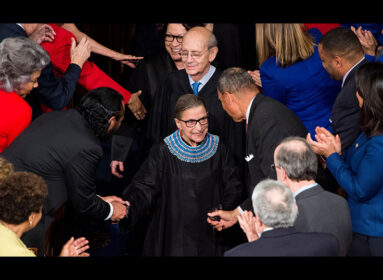
Jewish Ledger | 7-8-11
WEST HARTFORD – This summer marks two noteworthy anniversaries in the Chabad-Lubavitch movement. Seventy years ago this past June, the Lubavitcher Rebbe Menachem Mendel Schneerson and his wife, Rebbetzin Chaya Mushka arrived in New York. The couple had escaped Nazi-occupied Paris and survived several months in Vichy, France before boarding a ship in Lisbon, Portugal.
They joined the Rebbe’s father-in-law, the then-Lubavitcher Rebbe Rabbi Yoseph Yitzchak Schneersohn, who had been rescued from Nazi-occupied Warsaw in 1940. Schneersohn appointed his son-in-law to head the Chabad-Lubavitch social and educational outreach programs, carried out by emissaries (“shluchim”) dispatched from the New York headquarters throughout the world.
Rebbe Menachem Mendel Schneerson died on 3 Tammuz 1994, which corresponds this year to July 5.

Rabbi Joseph and Miriam Gopin (seated center), their children and grandchildren, at the wedding of their daughter, Raizel, to Rabbi Eli Rosenfeld several years ago.
In 1977, the Rebbe established a presence in Connecticut by agreeing to send Rabbi Yosef and Rebbetzin Miriam Gopin to Hartford, where the rabbi had extended family. Over the last 34 years, the Gopins and their children have touched thousands of lives through educational, religious, and cultural programs, as part of the Rebbe’s vision to revitalize Jewish life in the wake of the Holocaust.
Born in Israel, Yosef Gopin married Miriam in her native Melbourne, Australia in 1974 and the couple moved to New York so that Gopin could complete his rabbinical training. Before coming to Hartford, the couple served for nearly two years on the University of Massachusetts Amherst campus with Rabbi Yisrael Deren, who would later set up a Chabad House in Stamford.
The Gopins started out in a two-bedroom apartment off Farmington Avenue, establishing the first fulltime Jewish student activity program on the University of Hartford campus, with Friday night services and Shabbat dinners, holiday celebrations and classes.
They continued to emphasize programming for younger Jews when they brought the first branch of Chabad’s Camp Gan Israel to Connecticut in 1979 – now a network of thousands of locations throughout the world.
“The camp environment is an opportunity for kids to learn Judaism while having fun,” says Miriam. “A lot of learning evaporates during the summer, even for kids who go to religious school or Jewish day school all year ’round. Instead of taking a long summer break from Jewish learning by going to a regular camp, two weeks at Gan Israel allows kids to incorporate their Judaism into a fun summer program.”
In 1980, the Gopins bought a house on Farmington Avenue, with the support of local lay leaders including David Chase, Simon Konover, Harold Moffie, Harold Rothstein, Coleman Levy, and George Weiss, and expanded their programming to UConn.
“They were the leaders; they understood and appreciated the Rebbe’s vision and the community’s need,” says Rabbi Gopin. “The Rebbe’s vision was that the normative Judaism was not strong enough to equip our young kids when they leave their homes and travel to college to be able to keep their identity, their traditions, and their connection. After a short time, they became part of college life and, with that, adopted the college lifestyle and influences and became absorbed in the bigger community. Many went into drugs and cults and intermarriage. The vision is to be there on campus to guide them, to educate and strengthen and inspire them. We kept kids active and involved in Jewish life and that made them stronger and they could withstand the influences.”
In the ’80s, Chabad branched out into the community with holiday programming geared toward families, adult-education classes, and activities for senior citizens. They created programs for the Russian Jews being resettled in the community by the Jewish Federation of Greater Hartford. Larger holiday celebrations for Chanukah, Purim, and Passover were held at Beth David Synagogue. Rabbi Gopin established a presence at Wesleyan University.
In 1988, Chabad House of Greater Hartford opened its doors on Albany Avenue in West Hartford. Now community programs, as well as classes and twice-daily minyanim, could be held in-house.
Chabad expanded farther into Greater Hartford starting in the mid-’90s, when Rabbi Joseph Eisenbach came to Litchfield. Residents of Farmington Valley communities who came to Chabad House asked for more local programs, and in 1998, Rabbi Mendel Samuels was brought in to start Chabad of the Valley in Weatogue. In 2001, Rabbi Yosef Wolvovsky came to UConn, then brought Chabad to Glastonbury to serve communities east of the Connecticut River, including students at Wesleyan University.

Rabbi Shaya and Shayna Gopin

Rabbi Yosef and Yehudis Wolvovsky
As their nine children have grown into adulthood, most of them have worked at the center as educators, or moved elsewhere to start up a new Chabad house or join an existing one. Rabbi Shaya Gopin is education director at Chabad House of Greater Hartford, where his wife, Shayna, runs The Friendship Circle for children and teens with special needs. Mina is co-director of Chabad of Northwest Connecticut with her husband, Rabbi Eisenbach. Yehudis co-directs The Benet Rothstein Chabad Jewish Center in Glastonbury with her husband, Rabbi Wolvovsky. Chana is co-director of Chabad of the West Valley in Glendale, Ariz. with her husband, Rabbi Sholom Lew. Rivkah married Rabbi Schneur Zalman Kessler, head of the Yeshiva Gedola of New Haven. Mushka and her husband, Rabbi Yisroel Lein, are the new directors of Camp Gan Israel of Greater Hartford. Raizel and her husband, Rabbi Eli Rosenfeld, recently moved to Lisbon, Portugal. The Gopins’ two youngest sons, Dov Ber and Menachem Mendel, are yeshiva students.

Rabbi Schneur Zalman and Rabbi Rivkah Kessler

Raizel and her husband, Rabbi Eli Rosenfeld with their children
As the next generation of the Gopin family involved in Greater Hartford, Rabbi Shaya and Shayna Gopin moved to the area five years ago to develop programming for under-served segments of the Jewish population, including young families and children with special needs. The rabbi brings adult-education programs to where the students are, including the JCC and professional offices, private homes, even individual study meetings.
“We live here to fill any need a Jewish person may have – a class, counseling, a friend for a child with special needs,” Shayna says. “Our lives are for our extended Jewish family, spiritually and physically.”
Three years ago, the Gopins started The Friendship Circle, a national program with local support, which pairs teen volunteers and children with special needs for social and cultural activities. A teen board helps with governance and programming ideas. Because parents request new programming to follow their children into teen years and beyond, The Friendship Circle will launch a new young adult division in the fall.
Chabad House of Greater Hartford is an affiliate of Chabad’s Jewish Learning Institute (JLI), which offers courses throughout the year simultaneously at 300 locations around the country. As in all of Chabad’s adult-education programs, Rabbi Gopin says, JLI is designed to present challenging information and apply it to contemporary issues and times. A regular lecture series brings to the community speakers on diverse topics such as relationships, Kabbalah, and current events.

Dov Ber Gopin is a yeshiva student

Rabbi Joseph and Mina Eisenbach
“We’re lucky to have the teachings of Chasidism and the Rebbe, which enable us to have that contagious enthusiasm,” says Rabbi Gopin. “We try to always show the beauty and joy of Judaism, not ‘This is what I have to do.’ That’s part of our mission, and that’s what appeals to younger people: showing Judaism as a vibrant and relevant way of life. It’s not about dramatically changing one’s lifestyle, but adapting another mitzvah and another mitzvah, and coming closer to HaShem (God). We’re each on a ladder. The important question is, are we going up?”
People seek to learn from Judaism to answer challenging questions, says Shayna. “We draw from Torah in order to show how Judaism can become more relevant in modern life,” she says. “Teens want to learn more about the Jewish view on dating, intermarriage, and marrying Jewish. Mothers want to know about Jewish parenting, and many of them feel that there’s good advice in our Torah. Couples like to hear relationship advice from the Sages. For those dealing with elderly parents, there are very clear directives in the Torah for what we now call ‘the sandwich generation.’ We see the Torah as the best recipe for happiness in your life.”
When Rebbe Menachem Mendel Schneerson arrived in the U.S. 70 years ago, he brought with him a new approach to Judaism, one that recognized the realities of Jewish life in a secular society. “The Rebbe realized that Jews couldn’t maintain the atmosphere of the shtetl here; we couldn’t rebuild traditional Eastern European Jewish life here,” says Shayna. “Even those who tried to preserve an Orthodox Jewish lifestyle found that they had to adapt to American culture. The Rebbe’s answer was not to avoid the new culture, but to celebrate it. By doing so, you could create a more vibrant Jewish life in this country. He said, ‘We’re done with running away. We can live where we are and be better Jews.'”








 Southern New England Jewish Ledger
Southern New England Jewish Ledger








